Waterbird Weekend
Wing-watching with the crowd of thousands who gather lakeside for an annual aviation spectacle around–and above–Moosehead Lake
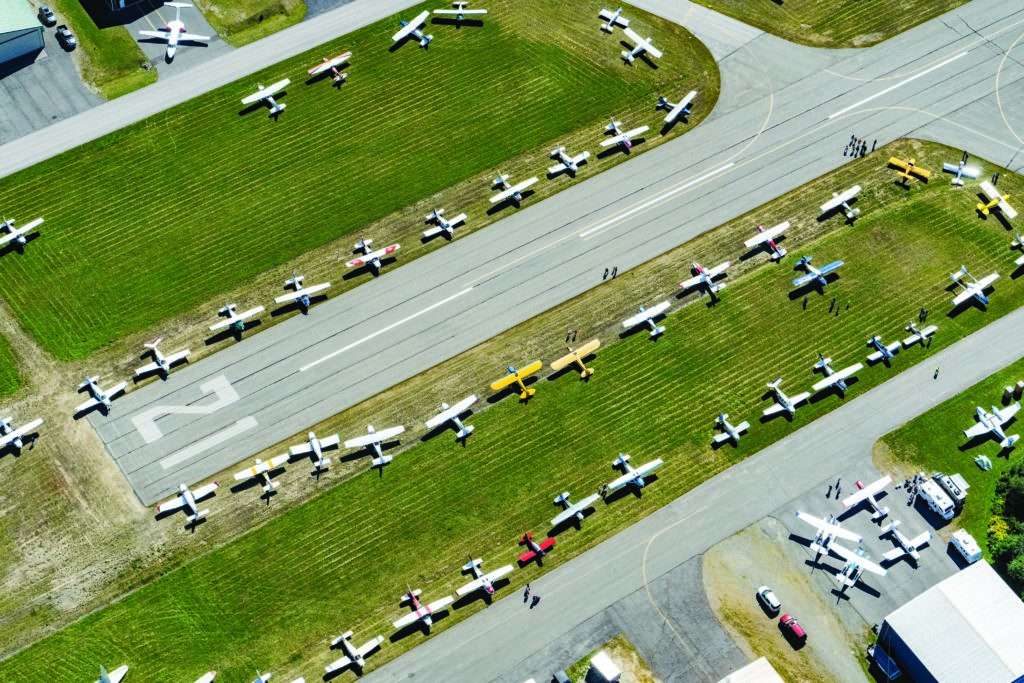
We’re still driving north, about 15 miles from Greenville, when we spot the first one. We’ve been checking the sky since our stop for fritters and coffee at Abbot Village Bakery a few miles back on Route 15, where the Friday morning counter was lined with hunks of pumpkin coffee cake and boxes of berry pies, and the conversation was all about airplanes and the 45th Annual International Seaplane Fly-In in Greenville. Just like others in the shop, we were ready to see the show of flight. Then, in the sky above the town of Monson’s main street, we get our first glimpse of a floatplane overhead.
By the time we reach the peak of the hill on Route 15 that gives the first “wow” view of Moosehead Lake, we’re getting an even fuller preview of the wing watching that’s in store. “There’s another, and another,” I say to photographer Peter Frank Edwards and his parents, who have joined us for the weekend trip. (His dad is an airplane buff.)
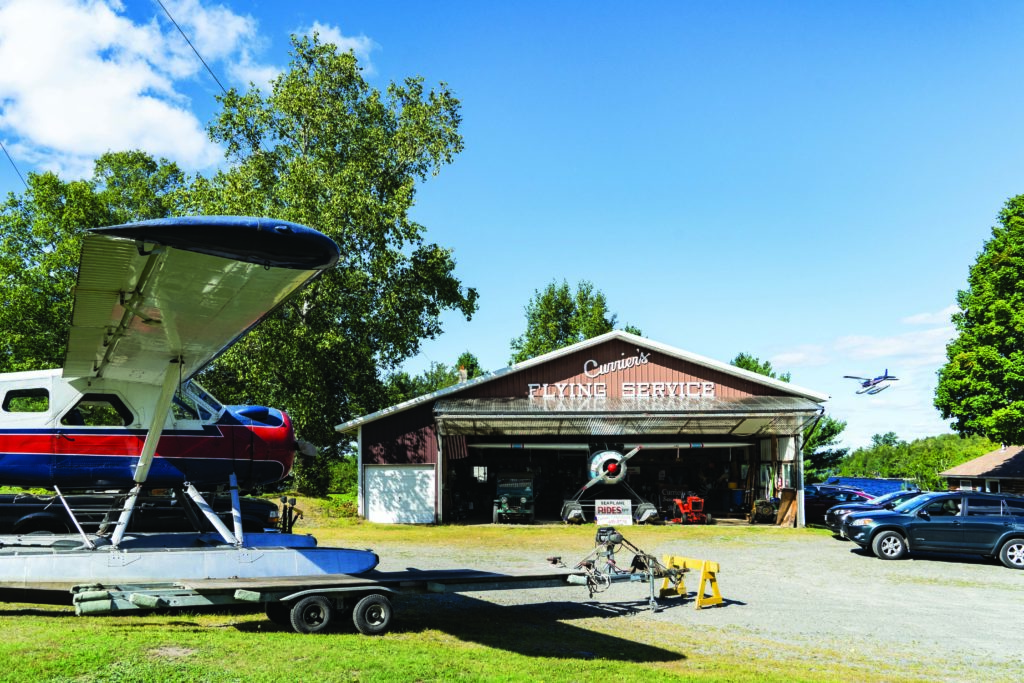
Soon, each of us is pointing skyward and commenting in turn. Even if you haven’t come for the planes, you can’t miss them. We’re suddenly seeing waterbirds everywhere.
On a cruise through Greenville’s shore-hugging streets, we pass the tall, open hangars at Currier’s Flying Service, with its vintage planes and signs for flight tours. The lakeside landmark has long been in place, but what’s different this weekend is the lively aviation action at every turn. At marinas and street-end coves we see floatplanes puttering about on the glinting surface of the lake, taking off sometimes, sometimes chugging to a landing.
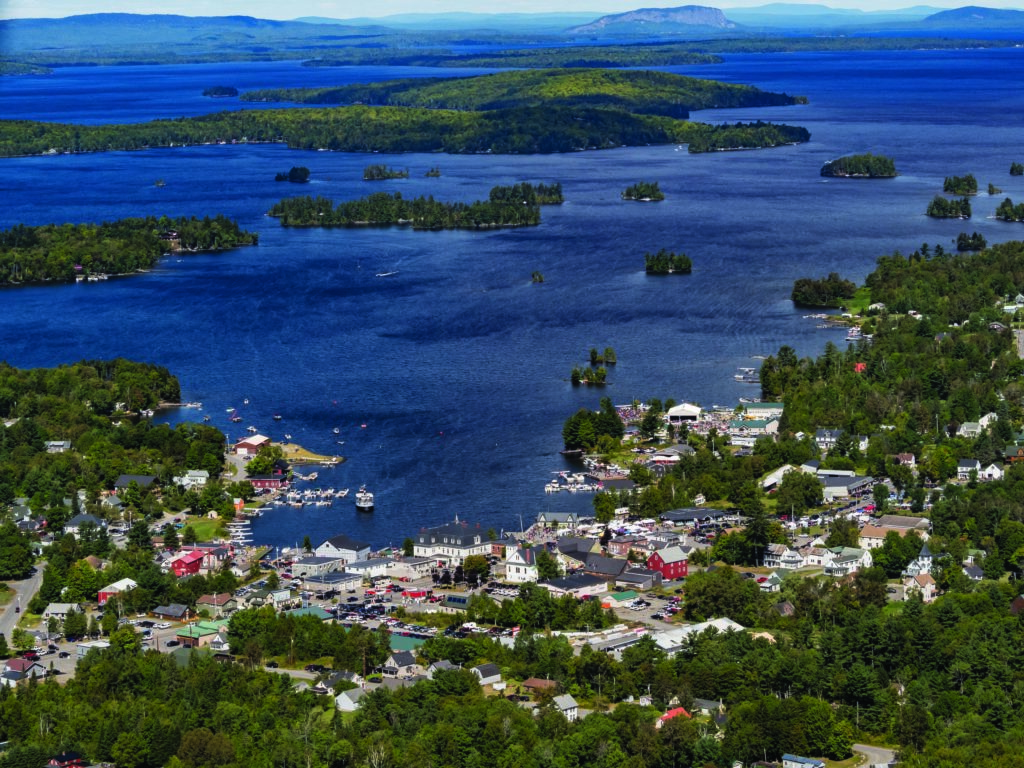
We’ve arrived for an annual ritual of flight in this Piscataquis County town with a year-round population of about 1,650. On the weekend after Labor Day each year, Greenville and its lakefront downtown buzzes with life on land and in the air. A flotilla of Piper Cubs, Cessna Skywagons, experimental models, and other seaplanes bob in the water, to be pulled up onto Moosehead’s edge or tied along docks. These vintage and new airplanes are fitted not with wheels but with buoyant floats that, if you squint, look like a pair of plump slippers or like those elliptical cream-filled doughnuts we eyed at the bakery an hour before.
All-Weekend Fly
The festival, first held in 1973, is in full, sunny swing. According to Fly-In lore, the gathering was founded by a group of Greenville-area bush pilots who made a living transporting the hunting and fishing crowd to remote camps in the mostly roadless North Maine Woods. They thought that getting together with likeminded pilots could be good fun, and they quickly realized that many participants would be making the 60-mile jaunt across the border from Canada, giving the Fly-In its international status.

“We have so many planes, we almost run out of places to put them,” says Keith Strange, an organizer for the Fly-In with a calm demeanor and a clipboard. He notes the turnout isn’t restricted to seaplanes. Besides the dozens of seaplanes, people arrive in wheeled planes that land and stay at the Greenville Municipal Airport, about a mile away. Some even camp out under their plane’s wings, he says, and we drive up to see dozens of aircraft snugly tethered along the grass runway on a hilltop. Many of the Cessna and Piper aircraft owners have pitched tents beside their planes.

Takeoff competitions on East Cove in Greenville. 
A quiet early morning at the Birches Resort in Rockwood, overlooking Moosehead Lake.
By chance, we meet Patrick McGowan when we’re looking at the PK Floats display—the Lincoln-based company has been making seaplane floats for more than 65 years. McGowan is the company’s president, and later I pick up a copy of his book One Good Thing, a caper set in the North Maine Woods that’s a love letter to flying and the adventure of a bush pilot’s life. “For a million years humankind had not been able to fly through the sky like a bird,” McGowan writes in the book’s opening pages. “It was surely one of our most disappointing shortcomings.”
The tremendous amount of open lake “runway” here is certainly a draw. The state’s largest body of freshwater, Moosehead Lake is about 40 miles long by 12 miles wide—a destination for seaplanes and all sorts of outdoor exploring, including fishing and boating and taking hikes to the top of Mount Kineo, with its 763-foot sheer cliff that towers over the water in the middle of the lake.
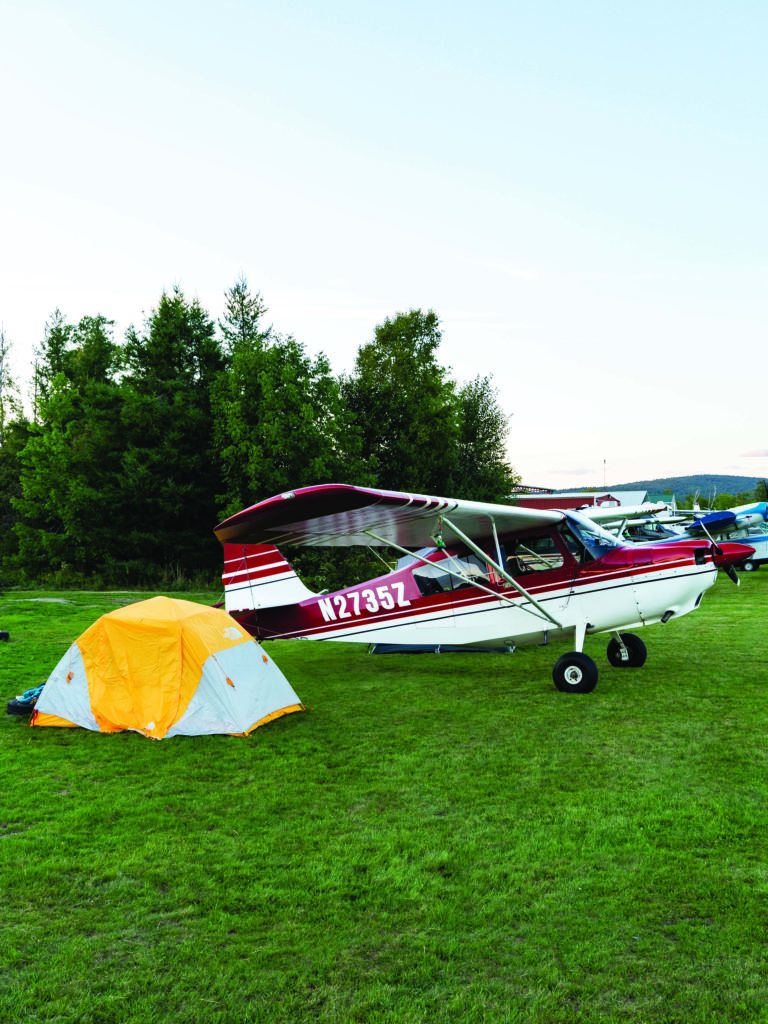
Some pilots fly in and camp out at Greenville Municipal Airport, about a mile from the lakefront action of the Seaplane Fly-In. 
Breakfast and a little balsa wood flight testing at the Birches Resort.
We’re booked for a couple of nights at the Birches Resort in Rockwood, which is a 20-mile drive along the Moosehead Lake shoreline from downtown. It’s out of the fray of the festival but is a seaplane hub, too, with plenty of festival guests. Across the water is Mount Kineo, and on Friday night a band plays Bob Seger covers while the restaurant and lounge in the log-built lodge is crowded for several hours with pilots and spectators for a Fly-In party. In the morning, all’s quiet again in the same rooms, and I sit by the stone fireplace—the resort staff have built and lit a fire before dawn—then take my coffee out to the porch to look over the calm, silver surface of the lake, with tufts of mist lifting as the sun rises.

Under Wing
“That deafening buzz you’re hearing, that’s not the engine,” says the announcer, his voice cutting into the air as the buzz wanes. “It’s the prop, breaking the sound barrier.”
It’s after breakfast. We’re back down at the Fly-In competition area along East Cove in Greenville and have found a place on the grassy point to sit. Not all of the planes are as loud, and some engines make more of a rumble or even purr as they gain speed in a splashing rise from the water. I have a similar posture to the rest of the crowd along the southernmost shoreline of Moosehead Lake on this sunny Saturday: leaning back, eyes on the waterline, then the treetops, and higher. We’re all watching planes take off and land, and the mood is like a tailgate party, with the onlookers stretched out on blankets or lawn chairs.
We watch the pilots rev their engines and half-float, half-fly across the water in a slalom course marked with orange buoys, then compete in takeoff runs where two planes start from the same point and see who can get in the air first. When the bush pilot canoe race is announced, everyone seems to pay particular attention. I happen to be standing next to Dick Harriman, a 72-year-old pilot from Prospect, who explains what’s happening and says to get ready, because it will go fast. “Don’t blink once Jimmy Dunn’s engine starts or you’ll miss it.” He’s right; it’s a frenzy of action. In a timed race, a two-person team goes from one dock to another—one person paddles an Old Town canoe, and the other maneuvers the plane between buoys, churning water as it goes. Once they both arrive at a dock in the center of cove, they lash the canoe to one of the plane’s floats and hop in the plane to fly back to the starting point, where they jump out and untie the canoe for the finish.

By now, we’re itching to get in the air, too. On the opposite side of East Cove, we meet Peter Thompson of Fletcher Mountain Aviation for a scenic flight over Moosehead Lake and Greenville. “People see Maine as different places like spokes on a wheel—Katahdin, Kennebec River, Greenville—but it’s all right here,” says Thompson, who’s been a pilot for more than 20 years and focuses on scenic and backcountry flights. “Maine is like a mini-Alaska, but you don’t know that until you see it from the air. Moosehead Lake is spectacular.”
Thompson’s plane taxis with some gurgles and splashes, and soon we’re rising up for a waterbird view, right over the Moosehead Marine Museum’s steamboat, Katahdin, which is offering cruises all day. We fly up to Mount Kineo and back, looking at the sparkling water, coves, and forests below. Everything is peaceful and ethereal from 1,000 feet up. And when we return, flying above the downtown and circling the airport, the planes below look like toys or game pieces.
After the flight we take a break for lunch at Flatlander’s Pub, a longtime downtown restaurant with about 40 seats. Inside, at our table near the four-stool bar with signs for RumChata and Fireball cocktails, we immediately smell something like vinegar fries. It’s actually the “broasted” chicken, prepared with a combination of pressure cooking and frying that creates a crisped skin and coating, so we order a plate to share. No cocktails needed; we have more flying to watch.
Back outside in the afternoon, the planes flying low in circuits around this end of the lake are coming by the minute now, and the whole town is thick with fans. Cars cruise slowly past, and people in line for an ice cream cone at the Dairy Bar gaze upward while they wait. Small groups are seated around or on top of fancy RVs, or are watching the show from docks and the decks of boats.
In event after event, we hear the announcer mention pilots with the surname Dunn. There’s Tommy Dunn in a 1953 Cessna 180, a red-painted Skywagon. And in the plane-canoe races, that blazing-fast winning team was Bill Dunn and Jim Dunn.
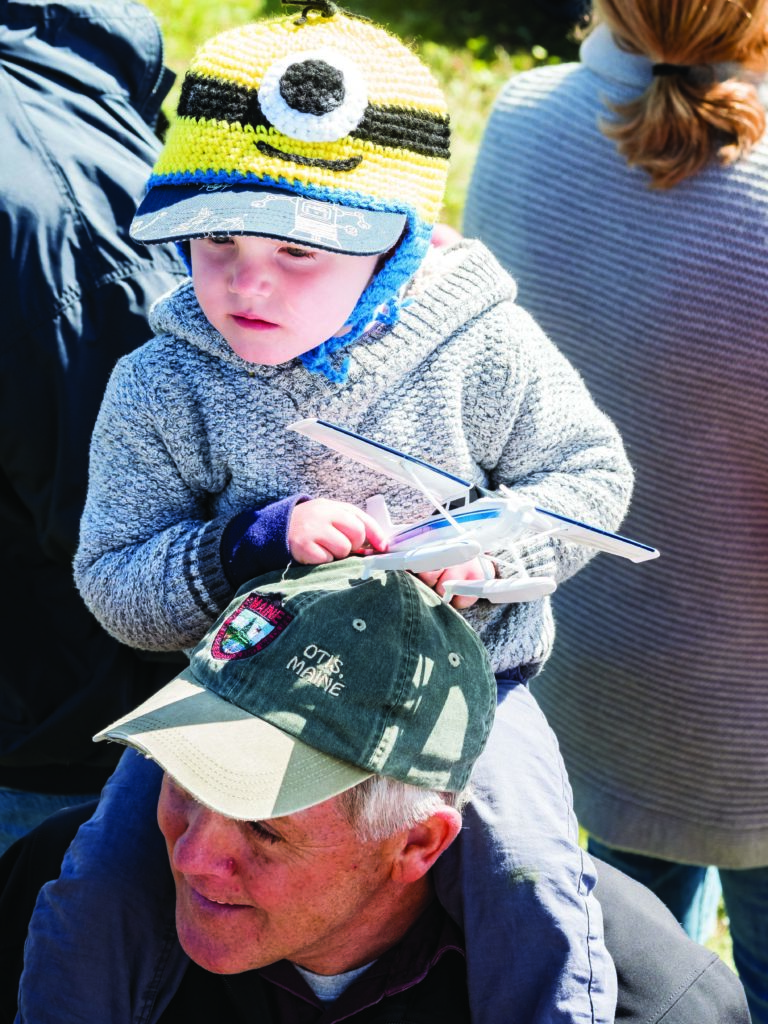
The Dunns are a four-generation flying family from Otis; many of the family’s men, women, and teenagers are pilots, and some work building planes. We find them gathered on a grassy point, where we end up meeting more than 30 Dunns, including George Dunn, who’s 85 years old and says he’s been participating in the Fly-In for more than 44 years. When he steps onto the float of one of the family planes, a couple of grandkids who were inside jump out. He smiles at them as they run past. “This is like our family’s Christmas,” he says.
A Large Sky
On the drive back home to the midcoast from the Fly-In, I’m thinking of a local man we met there who had arranged tables with brochures about things to see and do in the area. Wearing a cowboy hat and string tie, Charlie Boothby of Monson smiled at everyone who passed, and offered to answer any questions. I noticed a stack of his business cards, which read “Ambassador, Advocate, Writer, Moosehead Lake Region,” and I asked about his writing. Being in the outdoors here is a kind of therapy, he said, and handed me a copy of a one-page essay he’d penned. “If you’ve been living too long under the stress of life, if you cannot sleep at night, then it may be that you, too, need to make a close acquaintance with the cry of the loon, the swirl of the white water, and the blue outline of the mountains against a large sky.”
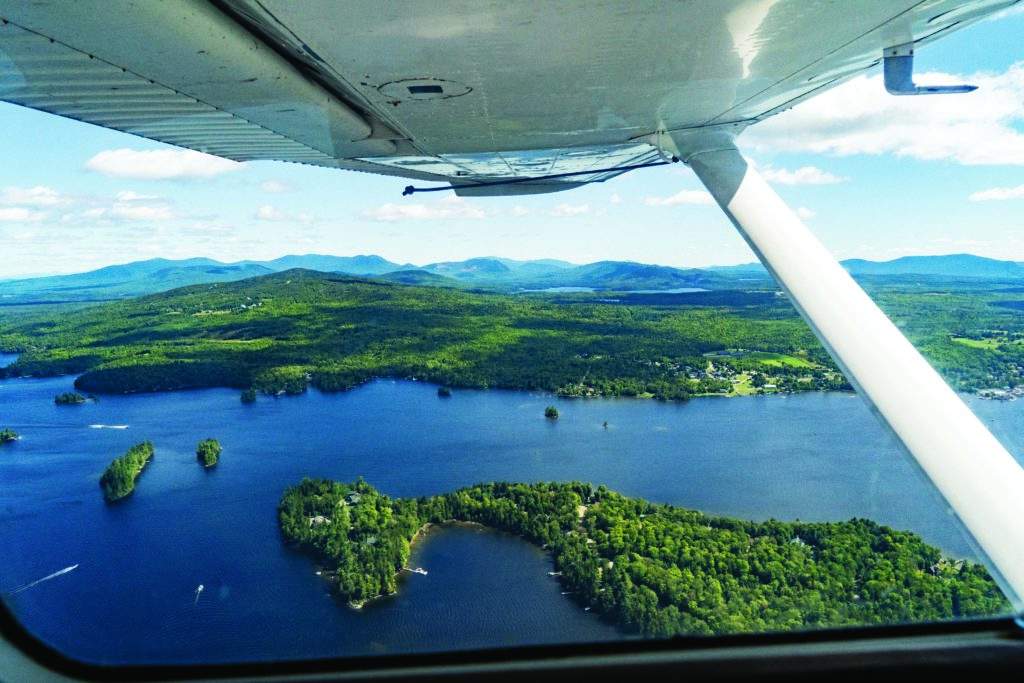
I read the passage again and think of the calm Rockwood mornings at the Birches, the festival’s competitions and competitors, and the scenic views from flight. In an amended version of Boothby’s Moosehead Lake scene, I picture the lake’s natural beauty and a manmade marvel, too: waterbirds buzzing over the wide water, above the treetops, and right up into that large, Moosehead sky.
2019 Fly-In
The 46th Annual International Seaplane Fly-In is set for September 5–8 on Moosehead Lake, with a lineup of activities for pilots and spectators in Greenville, about 75 miles northwest of Bangor by car (150 miles from Portland). More details can be found at seaplanefly-in.org.
Lodging books early for Fly-In weekend. Options include lakeside cabins, houses, and lodge rooms at the Birches Resort in Rockwood, which hosted our visit. More info about other resorts, inns, cabins, and campgrounds can be found on the Moosehead Lake Region Chamber of Commerce’s website at destinationmooseheadlake.com.

